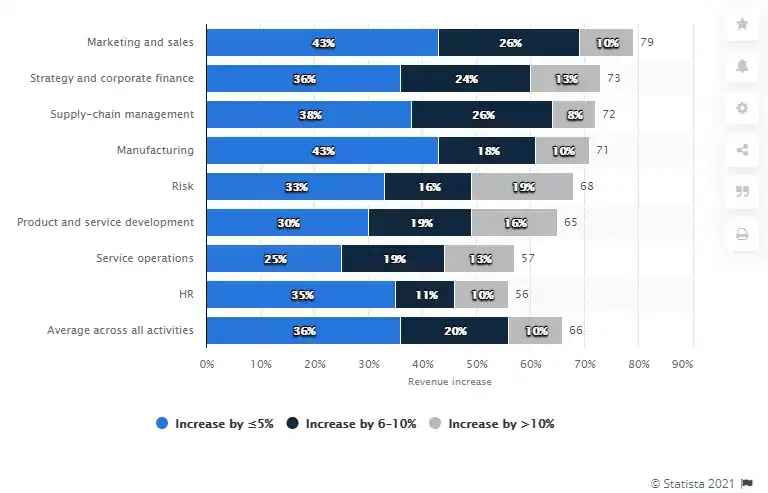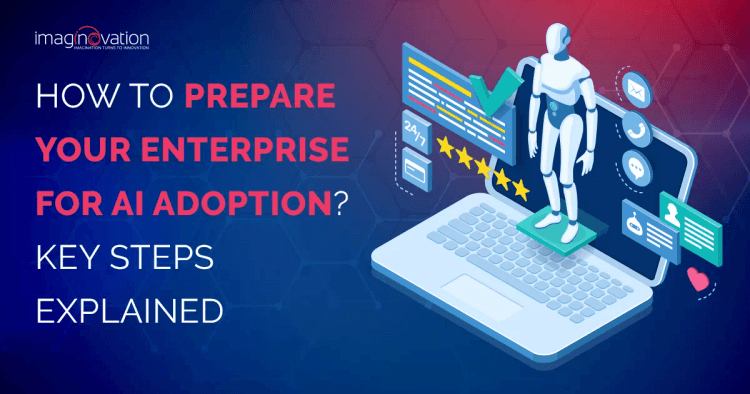Enterprise AI enables businesses to drive digital transformation by harnessing the power of artificial intelligence and machine learning. Not only does it improve day-to-day business operations, but it also accelerates decision-making across the organization.
According to McKinsey, AI will contribute 13 trillion USD to the world economy and raise the cumulative GDP by 16% by 2030.
For progressive businesses, the time seems right to leverage the benefits of Artificial Intelligence.
However, although this technology is becoming mainstream in the business world, we have noticed that many organizations are still not prepared to adopt AI.
Studies show that 79% of US business executives acknowledge the impact of AI on their enterprises, yet only 36% have some form of change management strategy for AI adoption.
In this guide, we will discuss how to prepare your enterprise for successful AI implementation.
Let’s get started.
Why Should Enterprises Invest in AI?

Business leaders always look for ways to increase business revenue, better efficiency, and excellent customer experience. You can achieve all this with AI by your side.
Look around, and you’ll see examples of AI adoption by many sectors. Intelligent chatbots, self-driving cars, and speech-based personal assistants have become a reality in business.
Take a look at the findings from a global AI survey showing revenue increase in various sectors.

Business applications have evolved and improved since the days of simple, old reporting.
Now, the applications can learn and predict – what you could do, where you could go, whom you could meet, and even what you might like to eat.
Armed with this new weapon to predict customer behavior, you can optimize your customer service strategy, improve processes and save substantial costs.
These AI-powered apps can deliver personalized experiences rather than the traditional ‘one size fits all’ approach. Also, applications can foresee relevant events much ahead of time and help decision-makers prepare for outcomes.
In short, investment in AI can help you:
- Improve business operations and hence productivity
- Accelerate decision making
- Enhance the customer engagement and retention
- Analyze massive data and get actionable insights
AI is no longer considered a long-promised business solution. Instead, it is evolving as a real-world spark that’s igniting changes.
The real challenge for enterprises is to figure out the best strategy for creating value from today’s AI investments and identifying and overcoming the landmines along the way.
Let’s find out how we can do that and stay ahead of our competitors.
Preparing Your Enterprise for AI Adoption – Key Steps
Despite the immense benefits AI brings to an enterprise, the number of companies that scaled up their AI pilot initiatives isn’t impressive.
In fact, most AI projects face budget cuts because they don’t deliver results fast enough.
So, is AI as technology to be blamed for this?
No. The real problem is not technology. It is the organizational culture and structure, which is designed for a pre-AI era.
For a seamless AI adoption, the organizations must develop a culture where business and technical teams can collaborate easily.
In short, to make AI truly beneficial for your business, you must be well prepared.
If you are contemplating artificial intelligence for your business, please read on and note all the critical steps.

1. Get Acquainted with AI
Typically companies tend to focus too much on the core development side of AI applications. Remember, AI is not primarily meant for software developers and engineers.
Although IT teams are undoubtedly responsible for building “smart” AI applications, AI skills are becoming increasingly important for everyone, including a non-IT manager.
“AI will not replace managers, but managers that use AI will replace those that do not,” Rob Thomas, senior VP of IBM’s cloud and data platform, told CNBC.
What you can do?
- Take steps to increase AI awareness throughout your company.
- Take the time to learn and educate others about what AI can do.
- Decide on internal or external AI education, depending on existing AI maturity within the company.
- You can opt to set up an internal AI academy with an on-the-job training program.
You can also choose from different resources available to enhance your team’s learning. There are many resources available to walk you through the basic concepts of AI. For Example, the TechCode Accelerator has partnerships with Stanford University and corporations in the AI space.
2. Identify and Shortlist the Problems You Want AI to Solve
Once you understand AI and its benefits, you can move to the second step of AI adoption. In this step, you need to identify the problems that AI would solve. Here’s how to do it:
- Explore different ideas of adding AI capabilities to your services.
- Keep in mind specific AI use cases that could solve business problems and offer value.
- Build an understanding of the prominent use cases to adopt AI. It will keep things on track.
Ensure that the primary reason for adopting AI is to realize specific business outcomes and not merely technology advancement.
At this stage, you must avoid some common pitfalls:
- Do not get caught up on which service, tool, or vendor has the best AI solution to offer.
- Do not lose focus on which business areas you would like to explore with the help of AI.
3. Assess and Prioritize the AI Initiative Value
It’s essential to assess and know the financial value of your AI initiative. It will help you prioritize the initiative based on its worth for the company.
- Assess and evaluate the potential business and financial value of the shortlisted AI implementations.
- Try not to get lost in the list of too many initiatives.
- Tie the shortlisted initiatives directly to their business value.
4. Rope in the C-suite
To realize the thorough value of AI, it is necessary that you get the C-suite of the company on board.
Why?
Senior managers and C-suite executives have a deep understanding of the company’s vision, business goals, and challenges. When they build AI awareness, they can:
- Form a clear understanding of how AI technologies function (like machine learning, machine vision, natural language processing)
- Recognize high-value AI use cases within the company
- Shortlist specific AI tools & techniques their company can use to achieve business goals
- Identify the barriers to AI adoption and the impact on people’s roles.
- Make appropriate investment decisions.
C-Suite must be able to answer the following questions:
- Which business challenges can AI help the company with?
- In the next few years, how will AI adoption differentiate our company from the competition?
- Can we grow and capture market share with the assistance of AI?
- What steps are needed today regarding data availability, talent, and cultural change for adopting AI?
5. Be Aware of the Internal Skill Gap
If you find a gap between what you want to accomplish with AI and your company’s ability to achieve it within a given time frame, you’ve identified an internal skill gap.
Businesses must know what they can do and what it’s not from a technical and business process standpoint before launching a full-fledged AI implementation.
In Gartner’s CIO survey for 2018, 47% of the respondents acknowledged the lack of specialized skills in AI and ML as their most significant pain point.
If there’s an internal skill gap, you’ll have to rely on the external service providers or hire new talent with the right skills.
You can also address your internal capability gap by identifying what you need to acquire and the processes that need to be internally evolved before you begin.
6. Build an In-house AI Team Partner with AI Vendors
Building an AI app is a lengthy process. Therefore, you need a reliable technology partner such as Imaginovation, to do it for you.
Let’s find out when to follow which strategy.
You can also partner with AI vendors to get specific AI tools or modules built for a large-scale system. It will be especially beneficial to find an AI vendor who has experience building a perfect tool for a specific use case. Vendor expertise shortens the AI learning curve for a new internal AI team.
7. Bring In Experts and Start a Pilot Project
Start small and prioritize your goals. Be aware of what you know and what you don’t know about AI. It is precisely where bringing in outside experts or AI consultants proves invaluable.
Do not invest much time in a first project. Usually, for a pilot project, 2-3 months is a good range. You can bring internal and external people together in a small team of 4-5 people.
Once the pilot is complete, you will decide what the longer-term, more elaborate project will be.
8. Break Down Data Silos
Data in an organization is stored in various forms by different departments. AI needs to access all the data stored. But the difficult part is that corporate departments store data in silos.
Silos are systems that are accessible by only specific teams. Not being accessible to all is a significant barrier to AI adoption.
But can we break down the data silos and integrate data?
Yes, but we can’t do it overnight.
Do not invest in an expensive, large-scale data transformation before implementing AI. It is best to do both together to transform data as per your AI initiatives’ needs.
Form a task force across different business units to manage data. This task force will be responsible for integrating different data sets and removing inconsistencies. It will make your data accurate and consistent.
9. Run Small Test Cases
I’m sure you’d agree by now that implementing a brand new AI strategy across the company will take time, effort, and money.
But don’t get disheartened and give up the idea of adopting this technology.
You can choose one area to test AI initially. It carries a much smaller risk of failure.
Why?
Because it’s easier to build an efficient system slowly, piece by piece. It leaves enough room for improvement in every iteration. At the same time, you can check what AI brings: which parameters were achieved and the entire initiative’s outcome.
Post this; you’ll be better positioned to plan further AI implementation and convince your executives why it’s worth investing in AI now.
For Example, you can begin by introducing AI chatbots. This alone can reduce the number of work hours your team spends on menial tasks.
10. Budget for Integration and Change Management
You can lay the groundwork for AI adoption by creating a company-wide AI awareness combined with employee buy-in for the AI initiative.
But is this sufficient to ensure a smooth AI integration with all business processes?
No. Besides these activities, you must budget for adoption activities just like you did for development.
Let me clarify how you can integrate AI tools with business processes.
Well, integrating AI tools involves workflow redesign, training, as well as change management. You must begin all these supporting activities well before deploying the AI solution. It will help prepare your team to work with new tools and avoid unpleasant surprises. If done well, it will ensure that the team is kept aware of and involved in its essential AI journey.
Moreover, when planning and preparing your enterprise for AI adoption can help you identify potential adoption barriers.
You will then take corrective actions – maybe redesign the workflow or modify the AI tool.
How to Tackle the Barriers?
AI has unlimited potential in transforming your business. Although it is set to play a significant role in your business’s growth and success, you may still face some challenges while implementing AI.
Let us check out some of those pain points and what shall we do to overcome them:
Lack of right skills
AI in business is still emerging. Therefore the number of experts is limited.
AI adoption requires the support of relevant subject matter experts and data scientists. But you will not find it easy and inexpensive to hire them. Moreover, you’ll have to be sure you’re getting the right people. Unless you’re an expert, you won’t know whether your new data scientist is good at their job.
If you are a small enterprise, you’ll find yourself with a limited budget to follow through with your AI initiative.
How do you proceed with the scarcity of experts available and the high expense involved?
You may consider finding a vendor for your AI. When you outsource the AI work, you can look at the vendor’s portfolio to see what projects they’ve delivered.
Not only is AI adoption an expensive process, but it is also equally time-consuming. Having an external team mitigates the risk: you can start with a small part of the system.
Managing data quality and quantity
AI works best with a vast amount of high-quality data. It learns from available information just like we humans do. But to learn from patterns, AI needs much more information to recognize features or understand concepts.
It means without sufficient data — or if the situation encountered does not match any past data — AI will falter.
It would work best if you made your data right.
Do not only rely on and use publicly available information. In this case, chances are your competitors will have the same information. It won’t give you an advantage.
Fear of unknown
Many companies do not fully understand the benefits of AI in their workplace. Then there is a fear of job loss, machines taking over the humans, and change management.
Develop a strategy to increase knowledge of AI in your company.
Also, quantifying the benefits of AI isn’t always easy. While some benefits like increased revenue and time saved have well-defined, quantifiable values, others, like enhanced customer experience, are difficult to define and measure precisely.
You may try to find ways to quantify all kinds of benefits and link them to specific key performance indicators.
Work towards creating a change management strategy for your business.
Prepare Your Enterprise for AI adoption with Imaginovation
Are you looking for innovative ways to solve business problems while cutting costs and saving time?
We can help you understand AI and how it can build services for the future.
If you're interested in exploring AI technology but aren’t sure where to start, we can help you develop a strategy for your business’s AI revolution.
We are an award-winning technology company with extensive experience in crafting remarkable digital success stories for diverse companies. Let’s talk.
Ready to build an app, but not sure where to start?
We've got you covered. Click the button below to get started.





